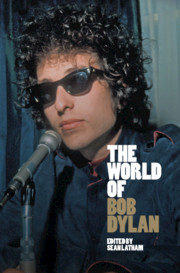42 results
Air quality and mental health: evidence, challenges and future directions
-
- Journal:
- BJPsych Open / Volume 9 / Issue 4 / July 2023
- Published online by Cambridge University Press:
- 05 July 2023, e120
-
- Article
-
- You have access
- Open access
- HTML
- Export citation
Chapter 7 - Ulysses in the World
- from Part I - Scope
-
-
- Book:
- The New Joyce Studies
- Published online:
- 01 September 2022
- Print publication:
- 08 September 2022, pp 110-120
-
- Chapter
- Export citation
Part I - Creative Life
-
- Book:
- The World of Bob Dylan
- Published online:
- 21 April 2021
- Print publication:
- 06 May 2021, pp 11-58
-
- Chapter
- Export citation
Part IV - Political Contexts
-
- Book:
- The World of Bob Dylan
- Published online:
- 21 April 2021
- Print publication:
- 06 May 2021, pp 237-286
-
- Chapter
- Export citation
Index
-
- Book:
- The World of Bob Dylan
- Published online:
- 21 April 2021
- Print publication:
- 06 May 2021, pp 341-352
-
- Chapter
- Export citation
Contents
-
- Book:
- The World of Bob Dylan
- Published online:
- 21 April 2021
- Print publication:
- 06 May 2021, pp v-vii
-
- Chapter
- Export citation
Further Reading
-
- Book:
- The World of Bob Dylan
- Published online:
- 21 April 2021
- Print publication:
- 06 May 2021, pp 335-340
-
- Chapter
- Export citation
Chapter 3 - Songwriting
- from Part I - Creative Life
-
-
- Book:
- The World of Bob Dylan
- Published online:
- 21 April 2021
- Print publication:
- 06 May 2021, pp 31-45
-
- Chapter
- Export citation
Acknowledgments
-
- Book:
- The World of Bob Dylan
- Published online:
- 21 April 2021
- Print publication:
- 06 May 2021, pp xiv-xx
-
- Chapter
- Export citation
Part V - Reception and Legacy
-
- Book:
- The World of Bob Dylan
- Published online:
- 21 April 2021
- Print publication:
- 06 May 2021, pp 287-334
-
- Chapter
- Export citation
Contributors
-
- Book:
- The World of Bob Dylan
- Published online:
- 21 April 2021
- Print publication:
- 06 May 2021, pp viii-xiii
-
- Chapter
- Export citation
Part III - Cultural Contexts
-
- Book:
- The World of Bob Dylan
- Published online:
- 21 April 2021
- Print publication:
- 06 May 2021, pp 145-236
-
- Chapter
- Export citation
Introduction: Time to Say Goodbye Again
-
-
- Book:
- The World of Bob Dylan
- Published online:
- 21 April 2021
- Print publication:
- 06 May 2021, pp 1-10
-
- Chapter
- Export citation
Copyright page
-
- Book:
- The World of Bob Dylan
- Published online:
- 21 April 2021
- Print publication:
- 06 May 2021, pp iv-iv
-
- Chapter
- Export citation
Part II - Musical Contexts
-
- Book:
- The World of Bob Dylan
- Published online:
- 21 April 2021
- Print publication:
- 06 May 2021, pp 59-144
-
- Chapter
- Export citation
Chapter 1 - A Chronology of Bob Dylan’s Life
- from Part I - Creative Life
-
-
- Book:
- The World of Bob Dylan
- Published online:
- 21 April 2021
- Print publication:
- 06 May 2021, pp 13-19
-
- Chapter
- Export citation

The World of Bob Dylan
-
- Published online:
- 21 April 2021
- Print publication:
- 06 May 2021
Chapter 11 - Industrialized Print
- from Part I - Historical Perspectives
-
-
- Book:
- The Cambridge Handbook of Literary Authorship
- Published online:
- 07 June 2019
- Print publication:
- 06 June 2019, pp 165-182
-
- Chapter
- Export citation
Chapter 11 - Serial Modernism
- from III - The Matter of Modernism
-
-
- Book:
- A History of the Modernist Novel
- Published online:
- 05 July 2015
- Print publication:
- 25 June 2015, pp 254-269
-
- Chapter
- Export citation
Abbreviations
-
- Book:
- The Cambridge Companion to <I>Ulysses</I>
- Published online:
- 05 October 2014
- Print publication:
- 27 October 2014, pp xxv-xxvi
-
- Chapter
- Export citation

